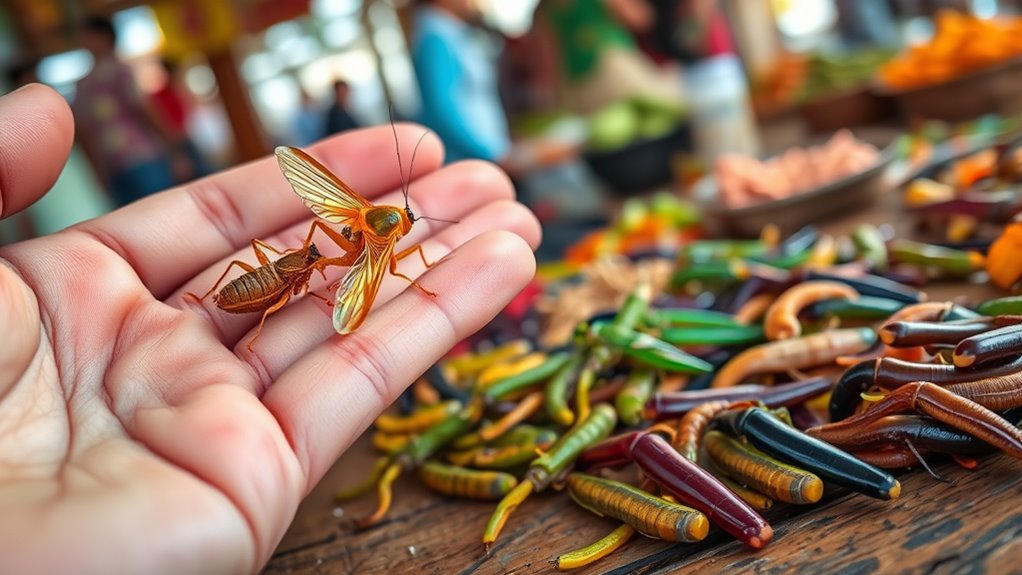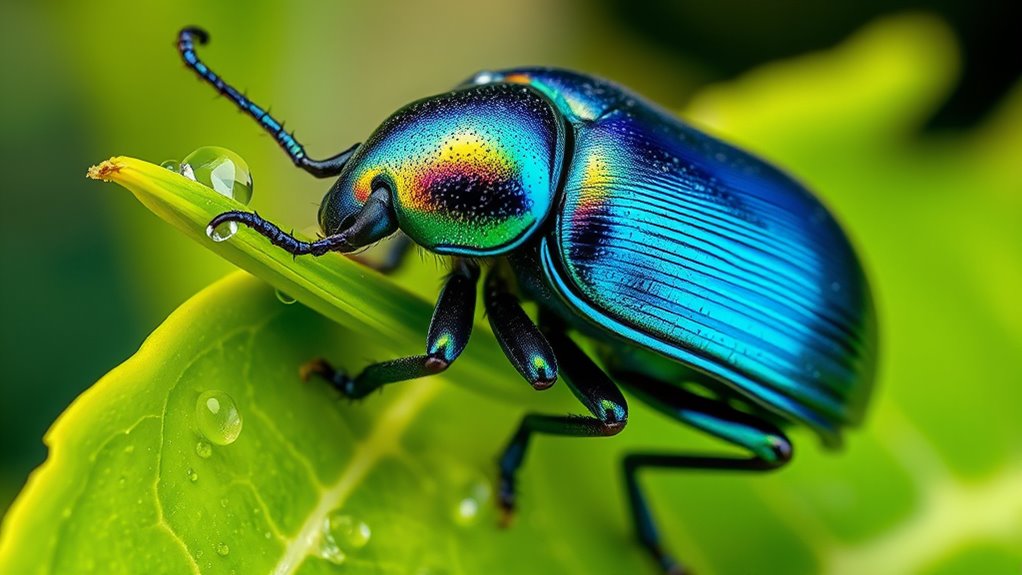Insect eating is gaining global recognition for its environmental, nutritional, and cultural benefits. In many regions like Africa, Asia, and Latin America, traditional dishes feature insects like grasshoppers and silkworm pupae, offering rich nutrients and unique flavors. Western interest is rising, with chefs creating innovative insect-based foods to support sustainability. Insect farming requires less land, water, and feed, making it a practical solution for food security. Keep exploring to discover how this ancient practice is shaping our future diets.
Key Takeaways
- Insect consumption is traditional in many cultures across Africa, Asia, and Latin America, valued for its nutritional and cultural significance.
- Growing Western acceptance is driven by sustainability, innovative culinary uses, and recognition of insects as a nutritious protein source.
- Insects like crickets and mealworms offer high protein, healthy fats, and efficient production with minimal environmental impact.
- Insect farming requires less land, water, and feed, supporting eco-friendly food systems and reducing reliance on conventional livestock.
- Incorporating insects into diets can help address global food security and environmental challenges through sustainable practices.

Have you ever considered how insects could be a sustainable and nutritious food source? In many parts of the world, eating insects isn’t just a tradition; it’s a practical solution to growing food demands and environmental concerns. Insects offer a high-protein, low-impact alternative to traditional livestock, requiring markedly less land, water, and feed.
For example, crickets and mealworms contain more protein per gram than beef or chicken, making them an efficient source of nutrition. Their fat content includes beneficial omega-3 and omega-6 fatty acids, which are essential for your health. Because insects are cold-blooded, they convert feed into body mass more efficiently, meaning they produce fewer greenhouse gases than cattle or pigs. This efficiency makes insect farming a promising strategy to tackle climate change while ensuring food security.
In many cultures, especially in Africa, Asia, and Latin America, eating insects is a common practice. You might find roasted grasshoppers in Mexico or fried silkworm pupae in Vietnam. These traditional foods are rich in nutrients and often considered delicacies.
The cultural acceptance of entomophagy—eating insects—continues to grow in Western countries, especially as people look for sustainable and innovative food options. Chefs are experimenting with insect-based dishes, highlighting their flavor profiles and culinary potential. Despite this, there’s still a stigma to overcome, but as awareness about the environmental benefits spreads, more consumers are willing to try insect proteins.
Producing insects for food is surprisingly efficient. They require minimal space and can be farmed vertically indoors, reducing the need for large land areas. Insects reproduce rapidly, with some species doubling their population in just days. This means you can generate a steady supply with relatively low startup costs.
Additionally, insects can be fed organic waste, which helps reduce food waste and recycles nutrients back into the ecosystem. This closed-loop approach decreases reliance on traditional agriculture, which often involves heavy pesticide use and deforestation. Insect farming is a sustainable way to produce protein while minimizing environmental impact.
As the world faces the challenge of feeding an ever-growing population, insect eating offers a compelling solution. You can contribute to this sustainable future by embracing insects as a food source. They’re versatile ingredients that can be incorporated into snacks, protein powders, baked goods, and even main courses.
Frequently Asked Questions
How Do Insects Compare Nutritionally to Traditional Meats?
You might wonder how insects stack up against traditional meats nutritionally. Insects generally pack more protein per gram and contain healthy fats, vitamins, and minerals.
They’re also lower in saturated fats and require less land, water, and feed. Incorporating insects into your diet can boost your nutrition and reduce environmental impact.
Are There Any Health Risks Associated With Eating Insects?
You might wonder if eating insects poses health risks. Generally, insects are safe if properly farmed and prepared, but contamination from bacteria, parasites, or pesticides can occur.
Allergic reactions are possible, especially for those allergic to shellfish.
To minimize risks, buy from reputable sources and cook insects thoroughly.
With proper handling, insects can be a nutritious and sustainable addition to your diet without significant health concerns.
Which Insect Species Are Most Commonly Consumed Worldwide?
Think of insects as tiny ambassadors crossing borders with nutritional gifts. You’ll find crickets leading the way in Africa, Asia, and Latin America, prized for their protein and sustainability.
Mealworms and grasshoppers also make frequent appearances on menus worldwide. These insects symbolize a future where food is abundant and eco-friendly.
How Sustainable Is Insect Farming Compared to Livestock?
You’re wondering how sustainable insect farming is compared to traditional livestock. Insect farming requires considerably less land, water, and feed, making it a more eco-friendly option.
Insects also emit fewer greenhouse gases, helping reduce your carbon footprint. Since insects grow quickly and consume less resources, you can produce more food with less environmental impact.
What Are Cultural Attitudes Toward Insect Consumption?
They say “you are what you eat,” and cultural attitudes towards insect consumption vary widely. In some societies, eating insects is seen as normal and sustainable, while others view it as taboo or unappetizing.
You might find that openness depends on tradition, exposure, and education. Embracing insects as food may challenge your perceptions, but understanding their cultural significance can open your mind to new, eco-friendly options.
Conclusion
As you explore the world of insect eating, one thing becomes clear: this ancient practice is evolving in ways you haven’t imagined. With new innovations and shifting attitudes, the future of consuming insects holds surprises that could change your perspective forever. Will it become a mainstream solution or remain a niche? The answer’s just around the corner, and once you see what’s coming, you might never look at these tiny creatures the same way again.









